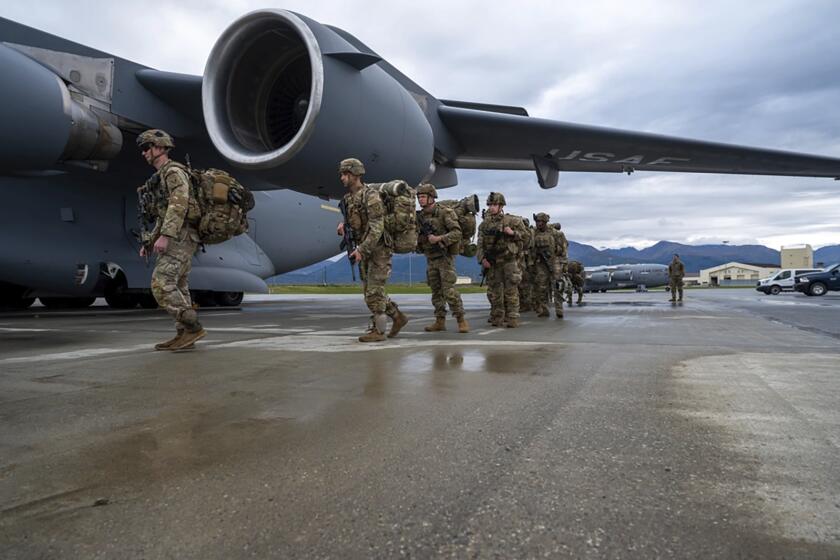Kadafi forces step up attacks amid allied airstrikes
Col. Moammar Kadafi’s forces intensified attacks in opposition-held cities, creating panic in the western town of Misurata, even as U.S. and allied warplanes broadened their airstrikes across Libya, U.S. military officers and witnesses said Wednesday.
Despite the increasing presence of allied aircraft overhead, Kadafi has rushed to put down the remaining pockets of a rebellion that has threatened his rule.
In Misurata, government forces resumed their assault Wednesday evening despite airstrikes for the second day on the outskirts of the insurgent-held city.
Photos: A meeting with prisoners held by rebels in Libya
Witnesses said Kadafi’s tanks closed in on a large medical center used to treat the injured and also as a rebel gathering point. Rockets fired by Libyan units have landed within 100 yards of the facility.
“The situation is very serious here in Misurata,” an opposition supporter said Wednesday evening. “The tanks are coming again to the center of Misurata city, and they are bombing the hospital at this time.”
U.S. officers said the U.S.-led campaign is refraining from airstrikes in urban areas to avoid causing civilian casualties.
Instead, the allied warplanes are hitting Libyan units outside cities, as well as supply lines and headquarters facilities, in hope of pressuring them to halt attacks against civilians, U.S. military officers said.
But the limitation on the allied strikes also appeared to give Kadafi’s troops freedom to carry out attacks relatively unimpeded once they make it into rebel-held cities.
Rear Adm. Gerard Hueber, a U.S. naval officer involved in directing the air campaign, said allied aircraft were attacking Libyan army targets across the country.
Even so, Hueber acknowledged that Kadafi’s forces had increased their assaults on rebel areas.
“In Ajdabiya, regime forces intensified combat in, into and out of the city. In Misurata, regime forces continue to clear opposition, increase combat operations and target civilian populations in the city,” he told Pentagon reporters, speaking from a ship off Libya’s coast.
At least four powerful explosions consistent with airstrikes were heard late Wednesday in central Tripoli from the direction of Kadafi’s Bab Azizia residential compound to the south.
The signs that Kadafi is moving forces and targeting opponents highlight the growing questions about how soon the U.S. will be able to hand off responsibility for the air operation to its allies, and whether they will be forced to escalate their confrontation with Kadafi to achieve even the limited goals of deterring his attacks on civilians.
If Kadafi’s forces are able to further suppress opposition to his regime without suffering severe losses from the allied airstrikes in coming days, the situation in Libya could turn into a lengthy stalemate.
House Speaker John A. Boehner (R-Ohio) on Wednesday presented the White House with a series of pointed questions about the U.S. military strategy and goals for the campaign.
“I and many other members of the House of Representatives are troubled that U.S. military resources were committed to war without clearly defining for the American people, the Congress, and our troops what the mission in Libya is,” Boehner wrote.
Ambassadors to the North Atlantic Treaty Organization met for the third straight day Wednesday to work out an agreement on who will assume command of the operation in Libya after the U.S. steps back from the lead.
One compromise envisions the coalition tapping NATO military structures and resources but leaving political command of the mission to another multilateral body.
The cracks in the coalition prompted Germany, which has opposed intervention in Libya, to pull military personnel from NATO aerial reconnaissance teams in the Mediterranean so they would not be participating in the Libya mission. But Berlin said it would assign 300 more troops to Afghanistan so that there would be no net effect on NATO personnel.
Photos: A meeting with prisoners held by rebels in Libya
Daragahi reported from Tripoli and Cloud from Washington. Times staff writers Lisa Mascaro and Paul Richter in Washington and Henry Chu in London contributed to this report.
More to Read
Sign up for Essential California
The most important California stories and recommendations in your inbox every morning.
You may occasionally receive promotional content from the Los Angeles Times.











